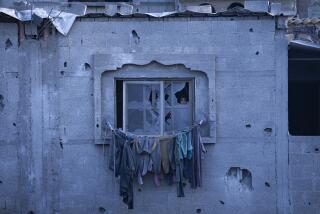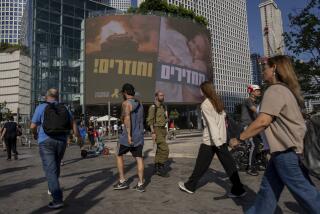Warrior Heals, Longs to Rejoin Battle
- Share via
On a cool August night 15 months ago, Eid Mohammed, a hardened Afghan warrior inhabiting the slim body of a teen-ager, slipped forward with a small band of rebels toward a Soviet garrison in the village of Chakmani.
Last week, while eating a hamburger at a McDonald’s in Woodland Hills, Eid recalled the events of the next few seconds, events that would later send him half a world away, to a strange place called Los Angeles.
“There was an explosion,” Mohammed said in his native Pushtu. He had stepped on a land mine. The blast blew away the heel of his left foot. Many bones in his ankle and foot shattered. Shrapnel flew into his legs and arms. “The next thing I remember is waking up in Pakistan,” he said.
Since September, Eid, now 17, has been living in a ranch house on a quiet street in Woodland Hills with an Afghan family--themselves uprooted after the Soviet Union invaded Afghanistan in 1979.
Along with 18 other wounded moujahedeen, or freedom fighters, Eid was flown to the United States this fall as part of Project Wounded, a relief effort organized by the Washington-based Committee for a Free Afghanistan and several congressmen. The United States government paid for the flights.
According to Mary Spencer, director of Project Wounded, 155 war-injured Afghans have been brought to the United States for medical treatment since the project began in 1984. The organization, which has a branch in California, plans to arrange treatment for 20 to 40 patients each month and is recruiting more hospitals to provide free medical care, Spencer said.
Congressman David Dreier (R-La Verne) arranged to have seven of the wounded, including Eid, placed in hospitals in the Los Angeles area. Eid is being treated by Dr. Charles Resnick, a surgeon at Orthopaedic Hospital of Los Angeles. Hospitals in the San Gabriel Valley are treating the other six.
Afghan families in the Los Angeles area have opened their homes to the injured men and boys while they recuperate, said Haji Mohammed Sarwar Roshan, Eid’s host. Eid will spend at least two more months living with Haji, his seven children, wife and mother.
Pain Was Too Great
According to Resnick, Eid’s foot was operated on by a team of plastic surgeons in Peshawar 11 months ago. “They did a pretty good job,” he said, but the pain was still too great to allow Eid to walk.
When Eid first visited the hospital, Resnick said, “he was scared out of his mind.”
Resnick found that the heel bone, which is normally flat on the bottom and spreads the weight of the body, now came to a sharp point. Fractures in Eid’s toes and the bones in the ball of his foot had never healed.
During a day of surgery, Resnick rebuilt the heel and fused the long bones in the arch of Eid’s foot. Platinum wires were implanted in Eid’s curled, paralyzed toes to straighten them.
If the bones do not fuse, Eid may have to undergo more surgery, Resnick said.
In the process of assessing Eid’s injuries and treating his foot, Resnick has seen the teen-ager six times, and they have become friends.
“My goal was to give him a less painful foot,” Resnick said. “That’s the best we can do. I’ll never be able to get rid of all the pain, but maybe he’ll get to the point where he can wear a normal boot.”
Over the course of an evening at Haji’s house last week, Eid, who has been a guerrilla since he was 10 years old, looked back over the events of the past 15 months. He also looked forward to the day when he can return to Pakistan, cross the border and rejoin the fight.
Sitting on flat cushions around an orange and purple blanket spread on a bedroom floor, Eid stretched out his left leg. A painting of Islamic pilgrims praying at the shrine in Mecca hung on the wall above his head. His foot, except for the toes, was encased in a cast. A platinum wire protruded from the flesh of each toe.
500 Afghan Families in County
Speaking in Pushtu, Eid related his story through Mohammed Kasem Lodin, a burly, gray-haired man who was a professor of engineering in Kabul before he fled Afghanistan. Lodin now lives in Reseda. He said there are about 500 Afghan families in Los Angeles County, 300 of which have settled in the San Fernando Valley.
Since his arrival in Los Angeles, Eid has stayed close to home because of the pain in his foot, watching television and meeting Haji’s Afghan friends. “They come to see a real moujahedeen, “ Haji said.
Last week, though, the pain subsided enough for Eid to walk without crutches for the first time. Haji took Eid on his first field trip, to Santa Barbara. He said the women there were pretty, but laughed and added shyly, “I do not look at them.”
Like most people who come to Los Angeles for the first time, Eid’s impressions revolved around traffic and the weather. And then there is the fast food. “I like hamburgers and pizza, but my favorite food is Kentucky Fried Chicken,” he said.
Eid said he and his three sisters and five brothers had been living with his parents in Peshawar, an ancient Pakistani city near the Khyber Pass now swollen by a a flood of Afghan refugees.
According to a United Nations report released in October, 5 million Afghans--nearly a third of the country’s population--have fled, creating the largest refugee population in the world. Most, like Eid’s family, have settled in Pakistan, where they remain encamped near the border, around cities such as Peshawar and Quetta to the south.
Eid’s family fled to Pakistan from their mountain village, Luz Wal Mungal, in 1982, after it had been bombed repeatedly by Soviet planes. From Peshawar, Eid and his brothers made periodic forays back into Afghanistan to attack Soviet and Afghan army convoys and garrisons.
During one attack on a Soviet convoy, a rocket hit Eid’s cousin, Nagi, killing him instantly and paralyzing an important rebel commander who had been standing nearby.
It was during another mission in the same area, Paktia province, which runs along the border with Pakistan, that Eid was injured. A Russian outpost at Chakmani had been besieged for several days by a large number of moujahedeen. Eid’s group of 30 rebels, led by a commander nicknamed Per Sab, “Big Man,” was moving in on the fort.
Shattered Foot
Eid was carrying a Russian-made Kalashnikov submachine gun when the earth erupted beneath his feet. “We didn’t know there were mines,” Eid said. The explosion that shattered his foot also ruined the legs of a friend standing next to him. That man, Wali Khan, is now being treated at a hospital on Long Island, Eid said.
One of Haji’s six sons, 16-year-old Fazlo, a student at El Camino High School, served a snack of dates, nuts, raisins and sweet tea with milk. Fazlo then spread an embroidered white cloth on the floor for dinner, which consisted of the traditional central platter of pilau, fragrant baked long-grain rice, chicken and flat bread.
The food was eaten with the fingers of the right hand. Afterward, everyone’s hands were washed over a brass bowl. No utensils were used.
By Afghan custom, Haji’s mother and wife, although in the house, never appeared that evening.
‘A Godless People’
“The big problem with the Rosoi is that they are a godless people,” said Haji, using the Pushtu word for Russians. Haji, who is unemployed, is a representative of the Unity of Scholars, Freedom Fighters and Refugees (Afghanistan), a relief organization based in Quetta, that is trying to obtain weapons and other supplies.
Haji took a picture album from a briefcase in the corner. A picture of an Afghan child holding a white dove was pasted to the cover. He opened the book and leafed through page after page of snapshots of wounded warriors. A man with a hole in his back. Another having his leg amputated without anesthetic. Another with a shattered foot.
“This is what the Russians are doing there,” Haji said quietly. “People here in America are big people. They can help a lot. They must know the truth.”
Eid pulled out several copies of a Peshawar newspaper published by the resistance, called Mahaz. The word, dominated by a single pen stroke curved like a scimitar, means “war.” Several front-page photographs depicted fighters standing triumphantly on the burned hulks of Soviet tanks.
History of Independence
The resistance effort is fueled by religious fervor and a strong sense of the country’s history of independence, Lodin said. “Seizing this country is very easy, but holding it is very hard,” he said. “It is a lesson the British have learned several times.”
But their hope is tempered by the reality of facing a heavily armed superpower on the battlefield.
“We have to modernize our side of the war,” Haji said. The need for weapons is almost equaled by the need for simple items such as radios, binoculars and boots, he said.
“Many freedom fighters have been lost because of a lack of simple things--antibiotics, vitamins, disinfectant,” said Haji.
One of Eid’s first questions when he arrived in Los Angeles concerned the availability of metal detectors, to help sweep areas suspected of being mined. “Otherwise I wouldn’t have this problem,” he said, pointing to his leg.
Raising the material of his pajama pant legs, Eid exposed the rectangular scars on his right calf where patches of skin were lifted and grafted over the wounds on his left foot. “I would go back to fight tomorrow if I could walk,” the young man said.
Eid stared intently at his foot. He smiled. “He is moving his toe,” said Lodin. Sure enough, the middle toe wiggled up and down a fraction of an inch.
More to Read
Sign up for Essential California
The most important California stories and recommendations in your inbox every morning.
You may occasionally receive promotional content from the Los Angeles Times.










